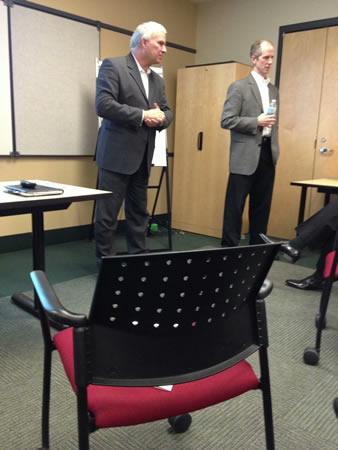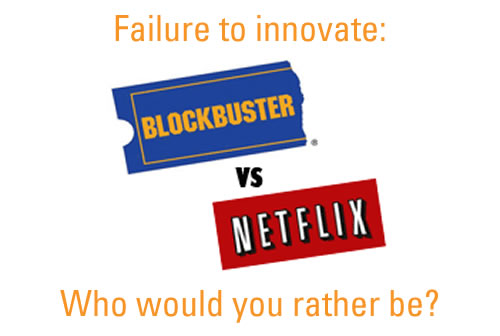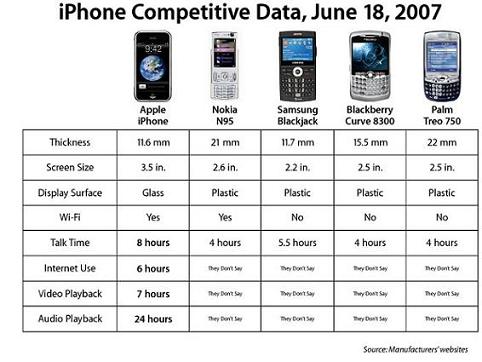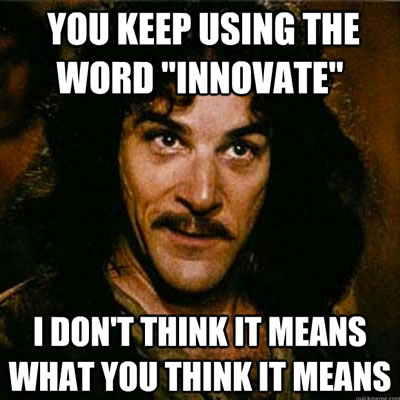If you’re a Canadian entrepreneur looking for some money to get your business idea off the ground, you should check out BDC, the Business Development Bank of Canada. They’re a bank owned by the Canadian government charged with the task of helping Canadian entrepreneurs get the funding and advice they need to be successful. I’ve had the pleasure of getting their financial assistance for my company, CTS, and they’ve been very helpful — in fact, a delight to work with. I cannot recommend their services highly enough.

Francois Viau and Bradley Munro,
two of the presenters.
Yesterday, the BDC held a short seminar and lunch featuring a talk on innovation at their downtown Toronto office at the corner of York and King Streets. I’ve had my head down in work and wasn’t really looking forward to attending it; I’ve sat through all sorts of presentations like this and have often come out saying “Well, there’s a couple of hours of my life that I won’t get back.” I was pleasantly surprised with this one: this had some interesting, engaging presenters, and I found myself taking copious notes on my iPad as they talked. All right, BDC, you’ve really won me over now (and hey, thanks for the business loan).
My notes from the presentation are below. Enjoy!
Innovation (presented by Bradley Munro)
Intro
- The 2 key problems that small businesses face:
- Lack of money to work on innovation
- Lack of people to come up with solutions
- Peter Drucker: “Because its purpose is to create a customer, the business enterprise has two — and only two — basic functions: marketing and innovation”
- Marketing: creating profitable relationships with customers
- Innovation: a demonstration to your customers that you’re trying to solve problems
- Innovation means growth, and growth means survival
- There are 1.2 million small business in Canada, and they account for 1/3 of the GDP
- That means that there’s lots of competition — innovation differentiates you!

What is Innovation?
- It’s the constant pursuit of strategic change, and a commitment to evolving your business model
- It’s about surprising and delighting your customers, getting better at what you do and helping customers solver their problems
- It’s a process that is disciplined and systematic
- It’s embraced at all levels, starting at the top
- It’s the responsibility of everyone in the organization – from the mail room up
- How to you capture your employees’ ideas, filter them and synthesize them?
- Consistency is key
- The process is customer-oriented, so it must involve customers
Big Innovation or Small?

The often-cited big, disruptive innovation.
- Most people think of big, disruptive innovation
- A favourite example of this sort of innovation is Apple, and how they disrupted the RIM, Nokia and Motorola
- This type of innovation is incredibly rare, the exception rather than the rule
- Most innovation is small, incremental
- Think about innovation as your retirement portfolio – you wouldn’t bet your retirement fund on a single oil and gas stock
- For SMEs, big, disruptive innovation should be the furthest from your mind
- A good example of small, incremental innovation: Tim Hortons
- Strange to think of the evolution of a coffee and donut shop as innovation, but it is!
-
They managed to stay on top and give us a reason to think of it as a destination for daytime meals
- Constant delivery of new products and services
- Stock has climbed steadily since 2009 and performing better than S&P 500
- Innovation is a demonstration of why the company cares about the customer and why the customer should think of the company as a service provider
- If you’re wondering if you should innovate, ask yourself: “Is my business growing?”
Innovation vs Product Development
- The difference is risk and your appetite for it:
- Small companies tend to be risk takers
- Medium-sized companies tend to be risk managers
- Large companies tend to be risk avoiders
- Small companies have the appetite for risk, but not the money nor the people
| Innovation | Product Development |
|---|---|
| High risk | Moderate/low risk |
| Uses new technology / capabilities | Uses existing capabilities |
| Lower success rate | Higher success rate |
| Idea | Commercialization |
| Game-changing | Incremental |
| Creative and collaborative | Process-oriented |
| Corporate | Functional |
| More with less | More with the same |

Microsoft is particularly guilty of this.
- The term gets misused a lot
- Most of what is called “innovation” is really product enhancement
Minimizing innovation risk
- Take a portfolio approach: diversify your investment
- Don’t bet the farm on one idea or a large project unless you have the resources to absorb failure
- Use a mix of small, medium and large projects
- Be strategic: do the ideas you’re considering fit the vision and long-term objectives for the company?
- Be disciplined in how you allocate resources – choose your battles carefully
- Have clearly-defined objectives: “I want x% of my revenue coming from these projects by this date”
- We all work better knowing what the expected outcome is
- Some companies are great at ideas but have no idea how to filter or execute them
- Some have great execution, but lack the imagination to come up with new ideas
- Take advantage of existing tax credit programs, such as SR&ED
- Lots of government programs to help offset the cost of developing new products
- Requires paperwork and effort, but the payoff is handsome
Four Key Factors in Innovation
- Strategy
- Take a portfolio approach – separate small from medium from big, and prioritize – low/medium/high risk, low/medium/high opportunity
- As owner/operators, set the tone with clear vision and objectives
- Set parameters for innovation ideation process (customers play a valuable role in this process)
- Establish performance criteria for new ideas
- Expect failure and support it – manage the process so that the ones that fail aren’t the news you went out n a limb for
- Take action: nothing kills innovation like being all talk but no action
- Demonstrate to others in the company that you’re listening and taking action on employee ideas
- Write off your R&D expenditures
- Structure
- More for medium size companies with more resources
- You don’t want to isolate your innovation efforts and keep people collaborating
- Use integrated teams and promote collaboration
- Successful companies ease back on the reins and lets people collaborate, giving people latitude to explore ideas
- Nothing drives lethargy in a company like doing nothing new for a long time
- Companies that don’t spend time on innovation end up spending their time on administration
- Be open to systematically testing and learning – you can do this incrementally
- Hold regular brainstorming sessions – once a month is fine
- Document what you’re doing – formally recapture innovation and R&D activities
- Skills
- Strong leadership: good communicator, relationship builder, broad business perspective
- Takes a team approach
- Look for partners to collaborate with and build new products and services
- Look for different perspectives
- Innovation requires good project management skills: you’re working from a blank slate
- Small businesses shy away from process, but it’s needed to go from small to medium and medium to large
- Process
- To be good at innovation, you need to be good at three things:
- Coming up with ideas
- Filtering them
- Developing them
- To be good at innovation, you need to be good at three things:
Innovation killers
- Setting the bar too high, especially with financial hurdles
- DCF/ROI/NPV criteria are ways to set yourself up for failure
- Unreasonable assumptions, unrealistic projections
- Home run syndrome – think of it as starting a little garden
- Not having discipline around project management
- Don’t let the innovation project fall by the wayside because everyone’s too busy
- Not taking action, even on small ideas
- Over-reliance on industry wisdom and “knows” – keeps you in the box
Summary
- Successful innovation is a disciplined process
- Best place to start for small companies is to inject some process around innovation
- Set reasonable, achievable
- Focus on customer, don’t sweat profits: they’ll come
- Smart small, test and learn
- If you have the benefit of resources, manage the risk with a portfolio approach
- Expect failure
- Maximize available tax credits
Q&A
- Q: How do you take a company from entrepreneurial to process-oriented?
- The best way to think about it is documentation
- Start with a proposal or product definition document
- Document critical stages of moving customer from in the door to out the door
- All projects should have documentation that has been written, reviewed and approved
- Documentation is the essence and underpinning of the innovation process
- Process is documentation!
- As you evolve the business and complexity and risk increase, you need more process
- Process is discipline
- Process is risk management
- Documentation is also necessary for tax credits
- Q: Relying on customers can sometimes limit innovation. What can I do about it?
- Customers play a fundamental role in the early stage
- Don’t want them “in your kitchen” as you develop and enhance your product, but you still want them as checkpoints
- Anything process-oriented is eligible for SR&ED
SR&ED, Innovation and R&D (presented by Rowda Mohamud)
- Innovation: transform new ideas into high potential ROI
- To innovate you may need to conduct R&D
- R&D happens in places you don’t expect: it even happens in bakeries
- Vast majority of R&D is being done in SMEs
- Half of Canada’s full-time R&D people are in Ontario
- R&D is an investigative process that improves upon industry standard practice leading to:
- Development of a new product or process
- Improvement of an existing product or process
- Challenging the knows, the folk tales
- Successful innovation requires formal project management of R&D
- Leads to greater confidence when undertaking riskier projects
- The processes you adopt effectively transform company culture so innovation becomes embedded
- Throw out the idea of trial and error and go with research and development
- Trail and error is random, haphazard
- Processes lead to confidence
- SR&ED gives $3 to $4 billion annually to R&D and is a model for the world — other countries emulate it
- 40% goes to small companies
- Its purpose: to help Canadian entrepreneurs take on technologically challenging projects
- The structure and execution of R&D projects will determine the amount of investment tax credits
- Effective management of innovation-driven R&D projects requires
- Defining technological objectives and key success criteria
- Proper planning of investigative and experimental activities
- Clear identification, allocation and tracking of R&D resources
- Creating a systematic documentation process that is ongoing
- Software companies lag in claiming SR&ED; they’re doing R&D without even knowing it
- People don’t do their basic due diligence
- SR&ED projects have to be on a gap with your industry
- You don’t have to patent
- Encourage your employees to be truthful – there are no bad ideas
- CRA says that SMEs are weak at tracking their time
- Language for SR&ED is enshrined in the income tax act, but CRA is free to interpret
BDC (presented by Francois Viau)
- The BDC’s mandate to be profitable — it’s not blowing taxpayer money
- Currently, it has 2000 employees, 28000 customers and has 16 billion in loans
- Complementary to other banks
- Why would the government set up a bank?
- Unlike commercial banks, BDC works primarily for the entrepreneur
- They don’t reproduce what other banks do
- BDC would finance an innovation project; most banks would balk
- We’d like to show you 2 new BDC product ideas
- These products focus more on reach rather than revenue and bottom line
- They’re consulting products that are far cheaper than the typical consulting fee of $10 to $30k
- New product 1: Customized innovation workshop
- One-day session on your premises
- Purpose is to engage key members of your organization to stimulate strategic thinking to generate new, actionable ideas
- Understand how to manage an effective innovation process
- Facilitated by Bradley Munro
- Cost: $1000
- Outcome will include:
- Short list of new products or service ideas
- Apply creative thinking to business and tech issues
- Be better positioned for future growth
- New product 2: Customized SR&ED planning workshop
- Full-day session on your premises
- Purpose is to train key personnel how to identify, track and capture SR&ED activities to maximize investment tax credits
- Facilitated by Rowda Mohamud
- Cost: $1000
- Outcome will include:
- You’ll learn how to mitigate financial risk of innovation by structuring future development to take avatange of investment tax credits
- You’ll learn how to apply project management strategies to track SR&ED activity concurrent with innovation efforts

One reply on “Notes from the Business Development Bank of Canada’s “Igniting Innovation” Presentation, March 7th, 2013”
This insightful article provides valuable insights from the Business Development Bank of Canada’s “Igniting Innovation” presentation. It highlights key strategies and perspectives essential for fostering innovation and growth in today’s dynamic business landscape. The practical advice shared is invaluable for entrepreneurs and business leaders navigating the complexities of innovation. If you are looking for more information about bdc cdap loan then visit our website!